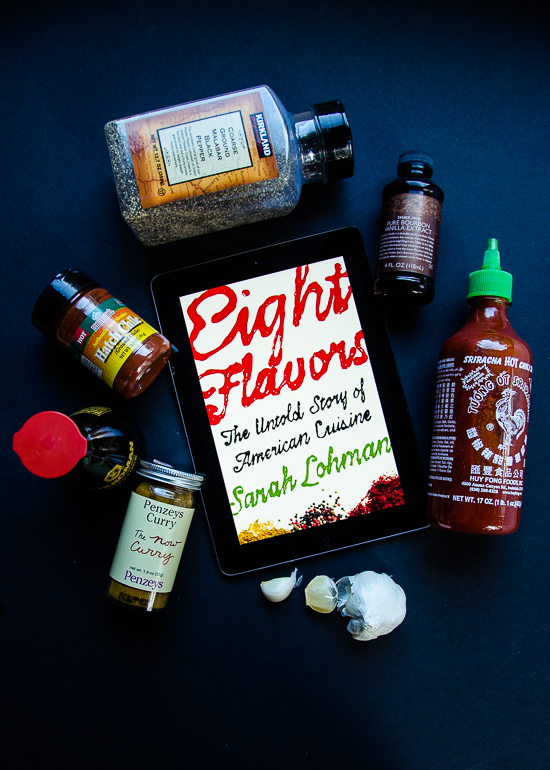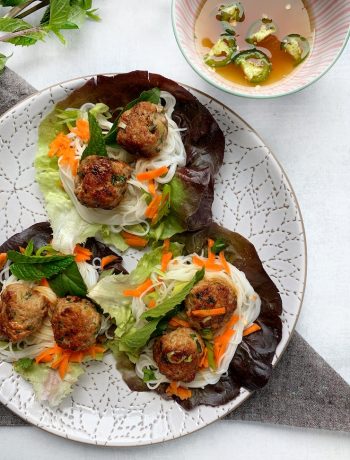**ARC provided by the publisher for review. I may receive a commission if you purchase an item via links below.**
Go look in your pantry and fridge and almost certainly you’ll find these eight items in your kitchen: black pepper, garlic, vanilla, chili powder, curry, soy sauce, sriracha, and MSG. They’ve been there so long, you probably take them for granted. And still, it’s hard to imagine how bland our diets would be without them.
Sarah Lohman’s Eight Flavors is part history, part food anthropology. Chronicling the arrival and mainstreaming of these eight ingredients on American shores and in American kitchens, it’s well-researched and full of interesting factoids. And now, in the aftermath of The Election, it’s a book that’s more relevant than ever as a new president prepares to enter the Oval Office.
Immigration has had an indelible influence on what Americans eat. In Eight Flavors, Lohman is bringing those immigrant stories to light and it’s an effort that’s to be applauded. Ingredients and dishes that may have started as a novelty were slowly but surely assimilated to fit “American” tastes of their time. It’s a book you’ll likely choose chapters to read based on personal interest in a given ingredient. I ended up jumping around rather than reading straight through.
It may be the lingering haze of The Election coloring my view, or the reminder that in America, you can be American and still not American enough, but here’s where I’m struggling with Eight Flavors. I’ve gone back and forth on this in my mind over the last week. Who is this book for? Is Eight Flavors meant for my Caucasian-American side, because it doesn’t seem to be for my Japanese-American side. (Not that you can really separate the two, but you get the point). Citations from the New York Times are rampant in this book. While the Grey Lady has long been regarded as “The” newspaper in the United States, it’s only one lens, and arguably a Northeast elite one, especially when we’re talking about the 19th and early 20th centuries.
My great-grandparents came to the United States from Japan in the early 20th century. My grandmother was born here. She was no less American than a kid who traces their ancestry back to the Mayflower, yet I can’t tell you how many times I’ve said, “Even my grandma was born here,” as if to prove just how American we are. In her American household (hyphenated though it might be), soy sauce and MSG were in the pantry alongside ketchup and mustard. The 1950 New York Times article, “Origin of Aji-no-moto” and its citation in Eight Flavors, hardly recognize an entire population on the other side of the country. A group which had been herded into internment camps just a few years earlier. A group likely to have had Aji-no-moto in their home kitchens. Post-internment, is that omission willful ignorance or a reflection of the Times’ audience?
It’s one citation, one article, but it gnawed at me. Would I have been as sensitive to it if I’d read the book before the election? I don’t know.
Eight Flavors is a solid, engaging read, but for me, it’s missing something critical: the hyphenate experience. The stories of how ingredients/flavors spread, not just from immigrants to whites in the United States, but within and among cultural and generational groups already here. There are some hints at it in David Tran’s story about creating Huy Fong’s sriracha, or when Eight Flavors talks about war brides bringing soy sauce with them to the United States and spreading it among their neighbors, but it’s more than that. There’s are newer narratives, I’d call them modern histories, that capture the stories of how cultures and food criss-cross and meld in America. If you’re interested in that history, check out Eddie Huang’s Fresh off the Boat and Roy Choi’s LA Son. Both have gotten press in the New York Times, by the way.
Eight Flavors is available for pre-order now and comes out December 6.
Rating: 4 stars
# # #





